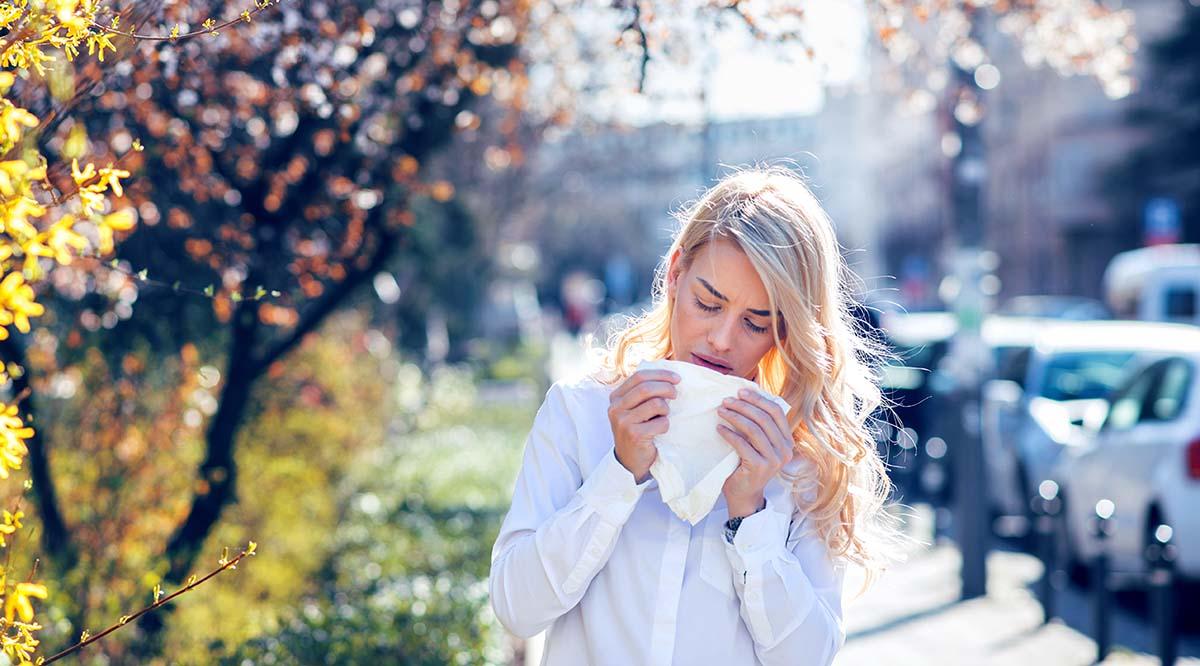If it feels like you’re suffering longer and more severely from springtime symptoms like itchy eyes, runny nose, and sneezing, it’s not just your imagination.
Scientists have reported that warming temperatures and other environmental factors have made seasonal allergens such as tree pollen, mold, and other spores worse over the past several decades. Not only are allergens thriving for longer periods than in the past — extending the pollen season by as much as three weeks in some parts of North America — they’re also reproducing at higher rates , intensifying allergy symptoms for many throughout the longer allergy season.
In 2021, 1 in 4 adults and 1 in 5 children — more than 80 million people — in the United States reported suffering from seasonal allergies, according to the Centers for Disease Control and Prevention (CDC). Though 2021 was the first year the CDC collected this data, allergists have reported anecdotal increases in patients seeking treatment for seasonal allergies in recent years, and some computer models suggest that climate change could significantly increase airborne pollen loads, even in areas that now have low loads, by 2050.
“There’s no question [that] as there’s global warming, the pollen season is increasing,” says Sanjiv Sur, MD, director and professor of Allergy and Immunology at Baylor College of Medicine in Houston, Texas.
Seasonal allergies may seem like little more than a nuisance, but they can have a bigger impact than many people realize, on both health and the economy, Sur notes.
Researchers in Sweden conducted a study in 2016 analyzing the economic impact of allergic rhinitis, or hay fever. They found there was a significant amount of allergy-related “presenteeism” (when a person is not sick enough to call out of work, but is sick enough to have reduced productivity). The researchers estimated that presenteeism, absenteeism, and medical treatment due to seasonal allergies had an economic impact of about $1.43 billion in Sweden alone. One 2011 study estimated the economic impact of medically treating seasonal allergies in the United States to be $3.4 billion annually.
Furthermore, there’s evidence that pollen and other allergens can damage DNA in the nasal cavity and lungs, causing inflammation. Pollen is also a common trigger for asthma attacks. A 2019 Environmental Protection Agency (EPA) study estimated that between 35,000 and 60,000 asthma-related emergency department visits were linked to pollen, and that those visits could increase by 14% by 2090.
“To me, [worsening allergies] highlight the fact that our health — even if you just have a pollen allergy — is being impacted by climate change,” says Mary Margaret Johnson, MD, PhD, a principal research scientist of environmental health at Harvard T.H. Chan School of Public Health in Boston. “And some have much more severe health consequences from climate change.”
Allergy causes
Allergic reactions are caused by the immune system detecting a foreign substance in the body and treating it as a pathogenic intruder, even though the substance is harmless. When an allergen, such as pollen, is detected, the immune system signals for the release of histamines — which cause inflammation and boost mucus production, resulting in the classic seasonal allergy symptoms of runny nose and cough.
There is evidence that allergies result from a combination of genetic inheritance and environmental factors during development. Genome-wide association studies (GWAS), which look at large sets of genetic code to identify variations, have identified associations between allergies and variations in the genes that code some cytokines, the proteins that regulate inflammation, according to a 2011 review . These same mechanisms influence other types of allergies, including severe food allergies, which can cause anaphylaxis — a life-threatening overreaction of the immune system.
Environmental factors
Though seasonal allergy symptoms are caused by the immune system response, they are triggered by allergens in the environment. Pollen is produced naturally as a means of reproduction for a variety of plants, but human activity — such as creating air pollution, using non-native and allergen-producing plants in landscaping, and the increasing temperatures caused by climate change — all contribute to the exacerbation of seasonal allergies.
Warmer temperatures have caused plants to blossom earlier and produce pollen longer than in previous decades. Air pollutants change pollen’s elemental composition and damage its surface, making it more allergenic . And plants that are popular for landscaping in urban areas can also release high amounts of allergenic pollen.
One horticulturist, Tom Ogren, has gained some notoriety for coining the term “botanical sexism” to describe city planners’ preferences for planting male trees because they produce fewer fruits and seeds (which can cover sidewalks and clog drains). He says that this has resulted in higher pollen counts and worse allergy symptoms, although some experts have disputed this claim since most trees have both male and female reproductive parts. Ogren, who has a master’s degree in agriculture and lives in San Luis Obispo, California, has written several books about his observations on allergenic plants and how to landscape and garden to minimize pollen. He also developed the Ogren Plant Allergy Scale (OPALS), which assigns ranks to a variety of plants to indicate their level of producing allergens.
Climate change is also associated with more extreme weather events, Johnson adds, creating more wind to help pollen travel farther.
Treatment and prevention
Though there is no cure for seasonal allergies, there are some tried-and-true ways to minimize their health effects. Here are some tips from Sur and Johnson:
Check local pollen conditions. The best form of prevention is avoidance. Johnson recommends checking local pollen counts and limiting time outdoors when they are elevated. The Weather Channel provides a local 15-day allergy forecast that gives values of high, moderate, low, or none for tree, grass, and ragweed pollen.
Improve indoor air quality. Johnson also recommends reducing exposure by running an air purifier indoors, and changing clothes and showering after being outside in high pollen conditions.
Landscape mindfully. The National Wildlife Federation encourages those wishing to reduce the amount of allergenic pollen around their homes to research the types of trees and flowers that they plant in their yards. Plants that are pollinated by wildlife, rather than by the wind, are less likely to release allergenic pollen into the air, making allergies flare up. Also, ensuring a diversity of plants reduces the likelihood of oversaturation of a particular allergen.
Use over-the-counter medications. According to Sur, intranasal corticosteroids , such as Flonase, are very effective at treating the symptoms of seasonal allergies, even more so than oral antihistamines. If the intranasal medication alone does not work, you might consider asking your doctor or pharmacist about antihistamines, decongestants, and other symptom-relief medications that can be used as second-line therapies .
Consider immunotherapy. For those with severe seasonal allergies that impact quality of life and prevent normal day-to-day functioning for more than a couple of weeks, both Sur and Johnson say that seeing an allergist is important. These physicians can test for specific allergies, and potentially administer immunotherapy injections, which are small doses of the allergen (given initially a few times a week for the first few months, and then monthly for 3-4 years) to desensitize the immune system.
Johnson warns those who experience seasonal allergies to be prepared for their symptoms to intensify in years to come, thanks to climate change.
“I haven’t heard a prediction that things will get better in terms of allergies, only worse,” she says. “We need to spend some more time researching ways to combat the allergy-related impact.”

